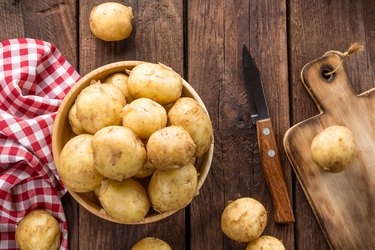
Potatoes are among the dirtiest types of produce, so it's crucial to properly wash these root vegetables before preparing and eating them.
Root vegetables like potatoes are grown in soil, so it's no surprise that some dirt is involved during harvesting. Potatoes may also be covered in pesticides and bacteria. Knowing this, you shouldn't skip giving potatoes a thorough scrub before enjoying them. There are plenty of produce washes on the market, but washing potatoes doesn't require any special cleansers.
Video of the Day
Video of the Day
Though it may seem obvious how to wash a potato, some methods are more effective than others.
Why Wash Potatoes Before Cooking?
There are several reasons why it's important to wash potatoes before cooking them:
- Spuds grow deep in the soil, collecting lots of dirt and coming in contact with fertilizer that coats the outside skin.
- Conventional potato crops are routinely sprayed with pesticides to ward off weeds and insects.
- They may harbor bacteria from being handled by others as they travel from the farm to the grocery store and to your kitchen.
Even if you'll throw away the skins, the Centers for Disease Control and Prevention recommends washing the exterior of vegetables anyway. This is because the germs and debris on the potato skin can get inside the potato when it's cut.
How to Wash a Potato
There are several different types of potatoes, and they should all be washed in a similar way.
The only equipment needed to rinse potatoes includes water and an optional vegetable brush. Washing potatoes with detergents, soaps or vegetable washes is not necessary or recommended, according to the USDA. Potatoes should only be washed immediately before preparing them.
Follow these steps to thoroughly wash potatoes before peeling, cutting, cooking and eating them, per the Food and Drug Administration:
- Wash your hands for 20 seconds with warm water and soap.
- To avoid cross-contamination, make sure any surfaces or utensils are cleaned and sanitized.
- Wash the potato by running it under lukewarm tap water to remove dirt and germs.
- Use a vegetable brush to scrub the potato to loosen any dirt that is stuck to the jacket of the potato.
- Optional: If soaking, place the potatoes in a clean bowl filled with lukewarm tap water for 20 minutes or less.
- Rinse the potato under running water to remove any loosened dirt or debris.
- Pat dry with a paper towel or clean kitchen towel.
After washing the potatoes, be sure to remove any parts that are green, sprouted or bruised with a knife that is clean and sanitized. Peeling the potato skin is optional and left largely up to preference.
While much of the potato nutrition is stored in the skin, it also harbors the most dirt and bacteria. Washing potatoes thoroughly is especially important if you'll be eating potato skins.
Tip
Washed potatoes should be cooked and eaten immediately. Wet potatoes can harbor bacteria, so avoid storing washed potatoes. Any potatoes that have been washed, peeled and cut should be stored in the refrigerator and eaten as soon as possible.
Fresh potatoes that haven’t been washed can be stored in a cool, dry, dark place.
How to Choose Potatoes
When choosing potatoes, look for smooth surfaces that are free of bruises, discoloration and cuts, as recommended by North Dakota State University.
These imperfections affect the quality of the potatoes. Potatoes should feel firm when squeezed — some softness is OK but you'll want to avoid mushy and shriveled potatoes.
Some potatoes may have a green hue or show signs of sprouting on the outside. Green potato skin has a bitter flavor and can be harmful if eaten in large quantities, according to the USDA.
Simply cut around the green or sprouted skin and prepare the rest of the potato as usual. If the potato is green below the skin, throw it out, per the U.S. National Library of Medicine.